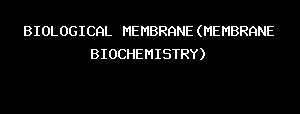
Structure and organization of membranes
Membranes are composed of lipids, proteins and sugars
Biological membranes consist of a double sheet (known as a bilayer) of lipid molecules. This structure is generally referred to as the phospholipid bilayer. In addition to the various types of lipids that occur in biological membranes, membrane proteins and sugars are also key components of the structure. Membrane proteins play a vital role in biological membranes, as they help to maintain the structural integrity, organization and flow of material through membranes. Sugars are found on one side of the bilayer only, and are attached by covalent bonds to some lipids and proteins.
Three types of lipid are found in biological membranes, namely phospholipids, glycolipids and sterols. Phospholipids consist of two fatty acid chains linked to glycerol and a phosphate group. Phospholipids containing glycerol are referred to as glycerophospholipids. An example of a glycerophospholipid that is commonly found in biological membranes is phosphatidylcholine (PC) (Figure 1a), which has a choline molecule attached to the phosphate group. Serine and ethanolamine can replace the choline in this position, and these lipids are called phosphatidylserine (PS) and phosphatidylethanolamine (PE), respectively. Phospholipids can also be sphingophospholipids (based on sphingosine), such as sphingomyelin. Glycolipids can contain either glycerol or sphingosine, and always have a sugar such as glucose in place of the phosphate head found in phospholipids (Figure 1b). Sterols are absent from most bacterial membranes, but are an important component of animal (typically cholesterol) and plant (mainly stigmasterol) membranes. Cholesterol has a quite different structure to that of the phospholipids and glycolipids. It consists of a hydroxyl group (which is the hydrophilic ‘head’ region), a four-ring steroid structure and a short hydrocarbon side chain (Figure 1c).
The sugars attached to lipids and proteins can act as markers due to the structural diversity of sugar chains. For example, antigens composed of sugar chains on the surface of red blood cells determine an individual's blood group. These antigens are recognized by antibodies to cause an immune response, which is why matching blood groups must be used in blood transfusions. Other carbohydrate markers are present in disease (e.g. specific carbohydrates on the surface of cancer cells), and can be used by doctors and researchers to diagnose and treat various conditions.
Amphipathic lipids form bilayers
All membrane lipids are amphipathic—that is, they contain both a hydrophilic (water-loving) region and a hydrophobic (water-hating) region. Thus the most favourable environment for the hydrophilic head is an aqueous one, whereas the hydrophobic tail is more stable in a lipid environment. The amphipathic nature of membrane lipids means that they naturally form bilayers in which the hydrophilic heads point outward towards the aqueous environment and the hydrophobic tails point inward towards each other (Figure 2a). When placed in water, membrane lipids will spontaneously form liposomes, which are spheres formed of a bilayer with water inside and outside, resembling a tiny cell (Figure 2b). This is the most favourable configuration for these lipids, as it means that all of the hydrophilic heads are in contact with water and all of the hydrophobic tails are in a lipid environment.

Advertisement

Link socials
Matches
